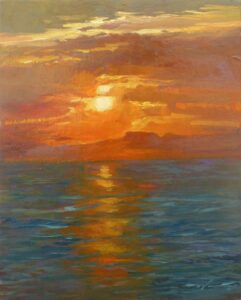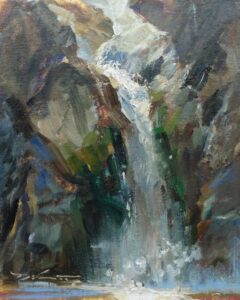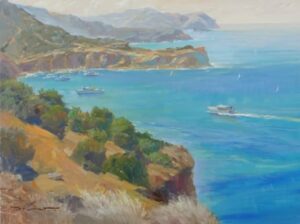To float like a cloud, you have to go to the trouble of becoming one.
-Robert Genn, Canadian painter

“This painting practically painted itself!”
“I found the sweet spot in this one!”
“FINALLY—I didn’t over-work it!”
In artists’ studios all across the English-speaking world, these thoughts are being expressed, either verbally or internally, on a daily basis (and in many other languages in different homelands). Ultimately, painters everywhere want their “work” to be invisible, for their efforts to seem effortless, so that the work looks masterful. The idea is that it would be clear to everyone that the artist has mastered the medium, and not vice versa.
I had the privilege to witness a painting demonstration by the master of portraiture Quang Ho. The block-in unfolded rapidly– the color palette defined the structure initially and efficiently. With every passing moment, the figure on the canvas revealed more and more of the spirit of the seated model, until—finally–Master Ho dashed in the final stroke of blazing white light for the shirt-front, that at once illuminated the face and finished the painting! Gasps from the audience were audible. His was an inspiring display of confidence, knowledge, and skill.
But it doesn’t always work that way. Even professional ballplayers don’t bat a thousand, or hit every three-pointer. Sometimes it’s just a lot of work. What’s the most efficient way to create an effortless—looking painting, despite its complexity?
If people knew how hard I worked to achieve my mastery, it wouldn’t seem so wonderful after all.
–Michelangelo Buonarroti
Of course, there is no “efficient” way to become a master. Think of well-known artists, actors, musicians, singers, athletes, doctors, teachers… anyone who is accomplished in their vocation. Now say these two words aloud: “overnight…success.”
We both know this is an oxymoron. Anyone who is good and great at what they do has worked long (usually unseen and un-rewarded) hours to get there, to the point where they wanted to be. They had a plan to get there, stayed focused on that plan, and divided and dedicated their available time to implement that plan, despite setbacks, self-doubt, and social judgment. A behind-the-scenes look into their backgrounds would reveal (many) failures to achieve desired goals, disappointments and rejection. But in those personal histories we would also find the will to succeed “no-matter-what.” Mustering self-discipline and courage was Step One on the road to accomplishment and mastery. As artists, we need to decide that we want to work, because we want to learn, experiment, and experience all that we are and who we want to become. As art critic Carter Ratcliff says, “Talent counts for much, but effort counts for more.”
Nobody’s a natural: you work hard to get good, and then you work hard to get better.
–Paul Coffey
Humility is a virtue to be greatly desired by artists. By now we know that no one comes into this world fully formed “from the brow of Zeus,” so to speak. Everyone is formed and developed from childhood through adulthood by innate personality, family, environment, and circumstances. And no matter how aged or seasoned we become, we find out that nobody knows it all. We need to learn the fundamentals, experiment with what works and what doesn’t, and learn from those who have already been there. And after we’ve worked for thousands of hours, our education will reveal a new way—our way—that will send us on the road to greater mastery over what we do. The understanding that we will never “know it all” is the fuel for our own passion to seek further, dig deeper, and create even more accomplished work.
Art is not delivered like the morning paper; it has to be stolen from Mount Olympus.
–Wayne Thiebaud
Seeking, digging, creating: these are “action”-words, suited to astronauts, adventurers, and artists. That “effortless” result we want will come via a ton of work, of trial-and-error experiments, failed forays and launches into the unknown. And it will come with big doses of pain. Have you had the experience of watching gallery-goers come into a room where one of your paintings is installed, and they all walk by it—without even a glance?! You just want to shout across the room, “Hey, that’s my painting! I worked hard on that! You’re not just going to walk right by it, are you?!” I’ve found that perhaps a healthier response is to use that indifference to take more risks, try something different than I’ve been doing, and to use my imagination to–as Francis Schaeffer writes– “fly beyond the stars.” It doesn’t even matter if my artwork appears to be effortlessly-painted, if there is no substantive idea behind it. Joseph Paquet www.joepaquet.com, that masterful artist, advises us in this way: “If you want to be remarked about, be remarkable.”
The object isn’t to make art, it’s to be in that wonderful state which makes art inevitable.
–Robert Henri
Whether you consider yourself to be a professional or amateur, you create art for your own reasons. Some will say that they create art for a living; others will say that they make art to share with others, and to share their appreciation for life; others will confide that they create art as a release from life’s pressures, and to center themselves. All of us would love to get to the level of enjoying it for the experience of doing it, and just not working so hard at it, to “get it right.”

Swimming is like that. I love to swim, and as a near-daily workout I find it to be simultaneously stimulating, relaxing, inspiring, and enjoyable. I have taught swimming and stroke-development, and can attest that every beginner (even those who want to learn) do not take to it “like a fish takes to water.” Some are anxious; some are fearful; some are terrified; and there are those who just want to throw themselves in the pool and work out the mechanics later. None of these attitudes are conducive to mastering swimming skills. There are fundamentals to be introduced, a sequence to learning the skills, trust in the process and self-discipline to be fostered, and mainly a decision to continue until the desired mastery is achieved. The correct state of mind is everything: all who want to learn how to swim can learn to swim. Beyond that, to be competitive, a swimmer will be putting in thousands of yards in the pool. So art is like swimming: it’s easy if you do it right. But how?
I’d like to leave you with some thoughts that I’ve had over my last thirty-five years of painting, in my countless attempts to improve my work, and to perhaps someday achieve that Olympian goal of mastering my medium. We all want to “do it right,” to achieve our visions in and for our painting. I hope this will help someone who is wondering if they will ever be able to swim to the other side. For those who are halfway across the pool, I hope that hearing these again may help to keep us on course.
- Put away self-doubt, as far as the east is from the west.
Accept from the outset that you will not do this perfectly. - Learn the Basics. Take time to learn from a mentor, to save you wasted hours in the ignorance of tried-and-true practices.
- Examine your use of time, and set aside time consistently to paint—and DRAW!
- Say no sometimes.
- Say yes to painting all of the time!
- Make a plan to achieve your goal. Write down the steps; make a calendar.
- Be organized, in your work space, on your palette, in your life.
- Put in the time to try; and KEEP trying!
- In your painting, don’t do as much, and as many un-related things.
- Don’t equate speed, or activity, with efficiency.
- Don’t include the world in your paintings. Listen to Matt Smith when he says” If you think your painting needs something, leave something out.”
- DO put down your brushstrokes and leave them there (all of them!)
- Approach each painting in humility. Leave the world behind. Start anew, above and beyond old baggage. “Create in me a clean heart…and renew a right spirit within me.” Psalm 51.
- Above all: Play. Appreciate. Wonder. Enjoy.
I send my very best to you, for your best efforts in your best paintings.

tom tailor says
great article. motivated me to continue painting.
Rick J. Delanty says
I’m glad this helps , Tom, thank you–what is intriguing about the craft and art of painting is that there is always more to learn. As artists, we commit to seeking knowledge everywhere we can, that we will be motivated–and more!–each time we begin a new canvas. Thanks for your comment!
Rosemary Holusha says
Thanks for the blog. I loved it. I love to swim and can’t wait for the pools to open on Memorial Day weekend. I attend Encanto Park Pool where we have a 50 meter olympic pool. I do not like swimming in small pools so never bought one. But I swim every day at Encanto in the summer. I am also a painter. What a beautiful combination of swimming and painting. I can’t imagine not swimming and feel sorry for non swimmers. As for painting, I try to enjoy it even on bad days. Yesterday I had a good day and I knew when to stop. I got lucky. Thanks for thoughts.
Rick J. Delanty says
Thank you, Rosemary–I feel the same about both painting and swimming: I cannot imagine not being able to do either. And even on bad days, we can celebrate just being ABLE to have the opportunity to exercise ourselves in this way. In the end, both of these help us maintain health, grow and develop , and view the world in new ways. Thank you for your comments–my best to you.
Marsha Savage says
I’m glad I came back to the blog after reading the post for today (1/17/2017)… just to see what posts I had not read. Yours! It is a very good one and I appreciate the thoughts you have spoken here. I have been painting for almost 45 years, and still struggle so much with who I am as an artist and why I paint what I paint! Your words above are right on point…. for a painter and a swimmer. I love to swim! Thanks!